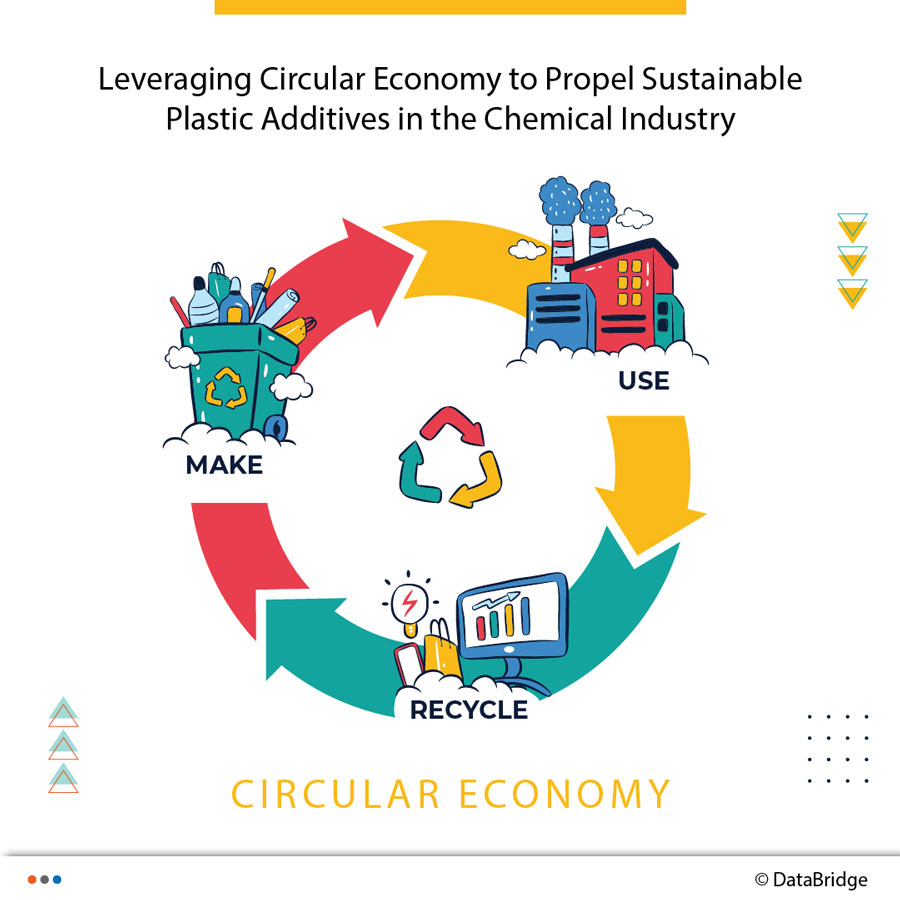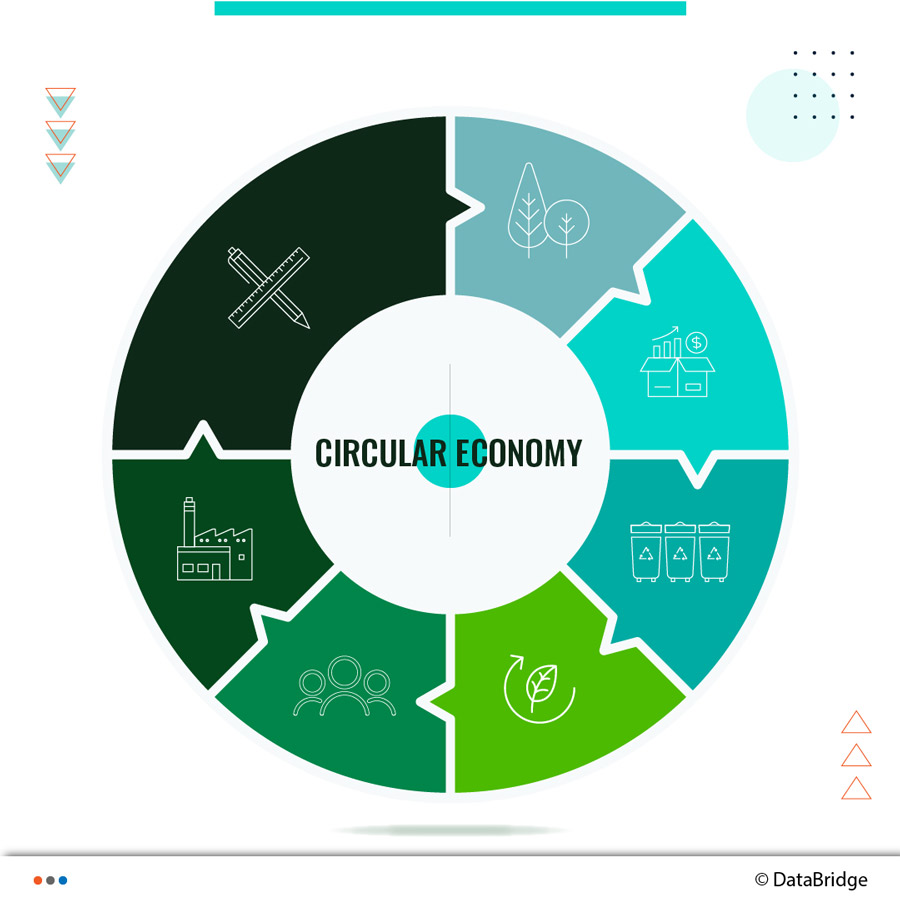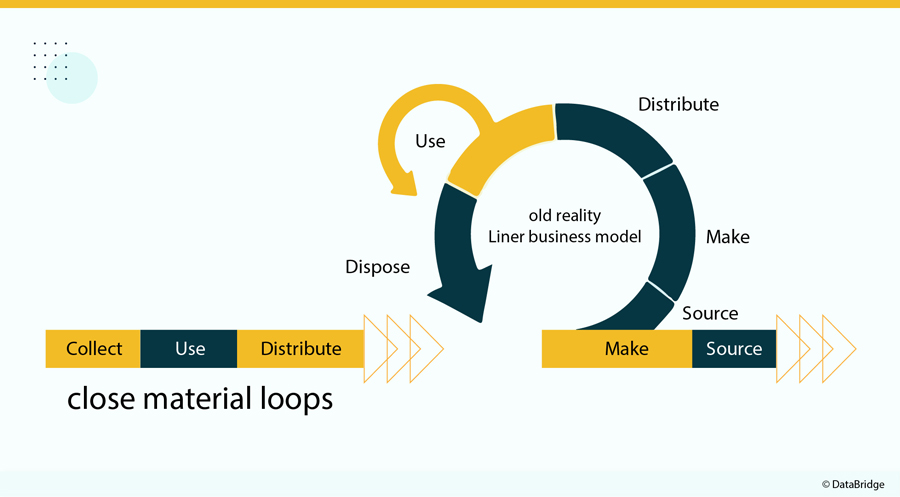Introduction
Global consciousness regarding environmental sustainability has reached new heights, driving industries to reevaluate their processes and products. Therefore, the chemical industry also stands at a critical juncture where innovation and sustainability intersect. With the rising concerns over plastic pollution and its detrimental effects on ecosystems and the environment, the adoption of circular economy principles has emerged as a ray of hope. One area where circular economy practices are poised to make a substantial impact is the realm of plastic additives. This white paper explores how the adoption of a circular economy in the chemical industry is expected to promote the utility of sustainable plastic additives, driving positive environmental outcomes and industry innovation.
Data Bridge Market Research analyses that the Global Plastic Additives Market which was USD 43.90 billion in 2022, is expected to reach USD 68.08 billion by 2030, growing at a CAGR of 5.8% during the forecast period of 2023 to 2030. An increase in the disposable income and rapid urbanization is the vital factor escalating the market growth. Also rise in the rapid growth in food packaging industries, increase in the low price and high durability of plastic and increase in the technology advancement are the major factors among others driving the plastic additives market.
To know more about the study, visit: https://www.databridgemarketresearch.com/reports/global-plastic-additives-market

The Importance of Sustainable Plastic Additives
Plastic additives play a crucial role in enhancing the performance, durability, and functionality of plastics. Plastic additives serve a critical function in enhancing the properties and performance of plastics. However, traditional additives often contain harmful chemicals and additives, posing significant challenges to environmental sustainability. The demand for sustainable alternatives has catalyzed innovation within the chemical industry, leading to the development of eco-friendly plastic additives that align with circular economy principles. Sustainable plastic additives offer a pathway towards mitigating the environmental impact of plastics while maintaining the essential functionalities that additives provide.
The PVC additives market is expected to witness market growth at a rate of 6.05% in the forecast period of 2021 to 2028. Data Bridge Market Research report on PVC additives market provides analysis and insights regarding the various factors expected to be prevalent throughout the forecast period while providing their impacts on the market’s growth. The rise in demand for the product from end-use industries is escalating the growth of PVC additives market.
To know more about the study, visit: https://www.databridgemarketresearch.com/reports/global-pvc-additives-market

The Emergence of Circular Economy in the Chemical Industry
During multiple global sustainability challenges, the circular economy has been listed as one of the biggest market opportunities for delivering the Sustainable Development Goals. The chemical industry stands at the brink of a new era of circularity, where products are crafted from renewable or recycled materials within closed-loop value chains. The essence of the circular economy lies in the notion of reducing waste and enhancing resource efficiency through closed-loop systems through closed-loop systems. In the chemical industry, embracing circularity involves redesigning processes and products to ensure that materials are reused, recycled, or repurposed at the end of their lifecycle. Major chemical companies across the globe have been at the forefront of this transition, pioneering sustainable solutions to address the challenges of plastic waste.
In the area of plastics, number of initiatives have been announced by the chemical industry, on its own or through partners, aimed at closing the loops for plastic waste where no economic or technological solution exists. However, the move to circularity requires vigilance and decisive action, as it promises to disrupt the industry’s value chains, profit pools and demand patterns while creating new opportunities for growth.
The shift requires intensive cooperation along the value chain and across industries. Below are some instances that show top chemical companies’ approach to integrate circular economy in their value chains:
- As a manufacturer of plastics, BASF SE is committed to promoting a more responsible use of plastics, recognizing their value as a resource that can benefit society if managed properly at the end of their life cycle. As a founding member of the global Alliance to End Plastic Waste (AEPW), BASF is dedicated to advancing solutions that address the issue of unmanaged plastic waste in the environment. Examples of these efforts include recycling TPU from worn-out shoes, rapidly expanding the ChemCycling project to convert mixed plastic waste into valuable products, and producing engineering plastics from post-consumer recycled carpets or PET bottles
- Borealis is adding value through its new plastics recycling technology brand, Borcycle, which enables the manufacturing of high-quality compounds from recycled polyolefins. In 2019, Borealis launched one grade of Borcycle containing 80% rPQ, suitable for visible appliance parts
- Eastman, which is a specialty materials company, is also actively engaged in addressing plastic waste within the framework of the circular economy. Through its carbon renewal technology, Eastman has developed an innovative process capable of recycling more plastic than traditional methods
Case Studies
Chemical companies can use the circular economy to make a lasting positive impact on society and the environment. As sustainability becomes more important, they can shift away from the old way of using things once and throwing them away. Instead, the companies can create systems where products and materials are used over and over again.
Chemical companies have a crucial role in making these circular systems happen. They can help build these systems that keep resources in use, leading to real circular economies. Many chemical companies are already moving forward with innovative ideas, like leasing chemicals instead of selling them outright, finding new ways to recycle plastics, and turning solid waste into hydrogen.

Clariant's Sustainable Evolution
Clariant, which is a leading specialty chemicals company, has embarked on a journey toward sustainability by launching innovative additives that support the evolution of plastics. At 2022, Clariant unveiled its latest range of additives designed to enhance the sustainability profile of plastics. These additives are engineered to improve recyclability, biodegradability, and overall environmental performance, marking a significant milestone in the company's commitment to circular economy principles.
Below are some recent advancements that enhance the durability of applications, supporting longer usage and promoting reuse in the journey towards circularity.
- Clariant has introduced a new anti-scratch additive for polypropylene (PP) and thermoplastic olefins (TPO) formulations called Licowax AS 100 TP, derived from renewable raw materials. This additive enables molded plastic goods used in various consumer applications to maintain their original appearance and texture for extended periods, thereby potentially prolonging service life and enhancing property retention for parts reusability
- Another innovation from Clariant is the AddWorks AGC 970, their latest light stabilizer solution for polyethylene agricultural films, which enhances product durability in the mulch segment
- Clariant's bio-based Licocare RBW 560 TP Vita offers improved thermal stability and lower volatility, allowing it to withstand higher processing temperatures and operate more effectively at lower dosages compared to conventional products. This additive is an extension of Clariant's Licocare range, known for its high performance and derived from renewable, non-food-competing feedstock such as crude rice bran wax, a by-product of rice bran oil production
These additive products and solutions from Clariant present promising opportunities for the plastics industry to strengthen the connections between efficiency and sustainability, safety and performance, as well as value and reduced carbon footprint.
BASF's Commitment to Sustainability
BASF SE, which is another key player in the chemical industry, has demonstrated a steadfast commitment to sustainability through its diverse portfolio of products and initiatives. In 2023, BASF introduced innovative solutions aimed at promoting the circularity of plastics. By leveraging advanced technologies and strategic partnerships, BASF continues to drive positive change within the industry, paving the way for a more sustainable future with their new products.
- In September 2023, BASF unveiled the industry's pioneering biomass balance offerings for plastic additives. The inaugural products, such as Irganox 1010 BMBcert and Irganox 1076 FD BMBcert, have been accredited by TÜV Nord for mass balance compliance under the International Sustainability and Carbon Certification (ISCC PLUS) scheme. These groundbreaking solutions enable the substitution of fossil feedstock with renewable alternatives, aiding customers in achieving their sustainability objectives.
- In 2022, BASF SE launched a program names reciChain, which is a technology-based ecosystem designed to connect all players within the plastics value chain. With this program, BASF hopes to reduce environmental pollution by promoting the traceability of plastic waste and the circular use of plastic.
BASF SE stands as the foremost innovative worldwide collaborator in plastic additives, prioritizing alignment with customer sustainability objectives. The company's BMBcert additives form a crucial component of the VALERAS portfolio, aimed at generating fresh value for plastics.
As per Data Bridge Market Research analysis, the sustainable plastic market will grow at a rate of 6.00% for the forecast period of 2021 to 2028. Rising government initiatives toward sustainable packaging is an essential factor driving the sustainable plastic market. The increasing demand as packaging material is escalating the growth of sustainable plastic market.
To know more about the study, visit: https://www.databridgemarketresearch.com/reports/global-sustainable-plastic-market
Moreover, brand owners are adapting to consumer preferences on circularity and taking a strong position by making voluntary commitments to increase the percentage of recycled and bio-based content in their products. For instance, Coca Cola has committed to making its packaging recyclable by 2025 and its bottles and cans of 50 percent recycled material by 2030.4 Unilever has committed to reducing its virgin plastic packaging by 350 kt by 2025, with 100 kt coming from an absolute plastic reduction. To fulfill these commitments, new value chain collaboration will be required
In addition, new players are entering the market to address the need for new technologies, and some established players are developing their own recycling technology units or cooperating with startups. The need for recycling technologies is by no means limited to waste processing, but, also involves platforms to trade recyclates, enterprise software to reduce waste, and sorting technology, among other things.
The Synergy of Circular Economy and Sustainable Plastic Additives
A circular economy for plastics that prioritizes resource efficiency aims to reduce unnecessary plastic consumption, utilize renewable sources for plastic production, operate on renewable energy, promote internal recycling and reuse of plastics, prevent any leakage of plastics into the environment, and aims to produce minimal to no waste or emissions. The adoption of circular economy principles in the chemical industry presents a unique opportunity to promote the utility of sustainable plastic additives.
By integrating eco-friendly additives into the manufacturing process, companies can enhance the recyclability, biodegradability, and overall environmental performance of plastics. This not only mitigates the environmental impact of plastic waste but also creates new avenues for value creation and innovation. Through collaborative efforts and strategic investments, the industry can unlock new opportunities for sustainable growth and contribute to a more circular and resilient future.
As an enabler and solution developer for many industries, the chemical industry has a critical role to play in promoting the circular economy. However, to successfully make the transition to circularity, the industry will have to cultivate new skills and adopt transformative technologies to recover and reuse chemicals from both industrial processes and end-of-life products.
For instance, mechanical recycling of plastics is a well-established standard process used with polypropylene or other polyolefins that can be separated and recycled, such as plastic car components. The recycled feedstock of these plastics is labeled as "recycled content", which companies can use as a green claim in their marketing.
As demand for recycled plastic increases, suppliers will have to find more ways to recover plastic waste and reintroduce it into the cycle as raw material. This calls for novel technologies such as chemical recycling, which breaks material down into its original molecules for better reuse.
Conclusion
Circular economy solutions play a vital role in closing the material loop, aiming to reduce waste and maintain materials within the economy, away from landfills and incinerators. In the short term, chemical companies should assess their operational processes and value chains to pinpoint opportunities for circular material loops that facilitate reuse and waste reduction. In addition, they should explore the feasibility of substituting feedstocks with bio-based or recycled sources.
As the chemical industry navigates the complexities of sustainability and environmental stewardship, the adoption of circular economy principles emerges as a catalyst for positive change. By promoting the utility of sustainable plastic additives, companies can drive innovation, reduce environmental impact, and create shared value for stakeholders. Through strategic partnerships, technological advancements, and a commitment to circularity, the industry can chart a course towards a more sustainable and prosperous future.


